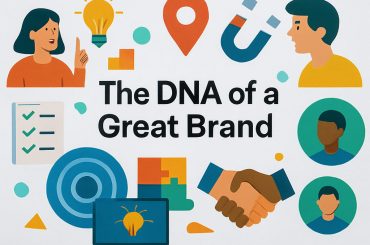Prologue: The Secret Behind Brands We Love
Some brands don’t just sell products. They live in our minds, our routines, and even our values. Think of Apple, Nike, or Dove. These brands don’t just win sales—they win feelings. Their secret weapon isn’t better prices or clever copy. It’s emotional branding.
In an age of algorithm-driven advertising and performance-obsessed funnels, emotional branding feels almost… poetic. But don’t confuse it with soft sentiment. It’s one of the most powerful levers of long-term loyalty, premium pricing, and cultural relevance.
This essay explores the mechanics, psychology, and execution of emotional branding—what it is, why it works, and how your brand can use it not just to convert, but to connect.
I. What Is Emotional Branding?
Let’s start with clarity.
Emotional branding is the strategic use of emotion to create meaningful relationships between a brand and its audience—relationships rooted in identity, memory, and shared values.
While traditional branding asks:
“What makes us different?”
Emotional branding asks:
“What makes them feel something?”
In this paradigm, the product becomes a symbol—a container for meaning. It’s not about what your offering is, but what it represents.
II. Why Emotion Wins in a Rational World
Humans like to think we make decisions logically. But neuroscience tells another story.
Key Insights:
- 95% of purchase decisions are made subconsciously. (Harvard professor Gerald Zaltman)
- Emotion, not logic, drives attention, memory, and action.
- People remember how a brand made them feel long after they forget what it said.
Emotion creates memory hooks. It builds affinity, increases trust, and raises willingness to pay. In an era where ads blur together, emotion is the pattern interrupt that lasts.
III. The Pillars of Emotional Branding
To create an emotional brand, you must understand and activate the following dimensions:
1. Identity
Your brand helps people express who they are—or who they want to become.
Nike isn’t just about sneakers. It’s about the identity of someone who pushes through.
Harley-Davidson doesn’t sell motorcycles. It sells freedom, rebellion, and brotherhood.
Questions to Ask:
- Who does my customer want to be?
- What does using my brand say about them?
2. Belonging
People crave community. Emotional brands create a sense of shared membership.
Think of:
- Lululemon’s in-store yoga classes
- Glossier’s “real girl” customer features
- Peloton’s live classes and instructors as emotional anchors
Key Tactic: Use content, rituals, and events to foster connection—not just consumption.
3. Storytelling
Stories trigger emotion in a way that facts can’t. They bypass the prefrontal cortex and speak directly to our sense of self.
Dove’s Real Beauty campaign didn’t show products. It showed how women see themselves.
Great emotional brands don’t just describe values—they embody them in narrative.
Story Types That Work:
- Origin stories
- Customer transformations
- Adversity and breakthrough
- Shared enemy or cause
4. Symbolism
Every great emotional brand owns symbols—logos, phrases, gestures, even packaging—that activate meaning instantly.
Think:
- The bitten Apple
- The Starbucks cup
- The red sole on Louboutins
- “Just Do It”
Tip: Don’t chase trends. Build symbols that reinforce your emotional promise over time.
5. Sensory Experience
Emotion is physical. The more senses you involve, the deeper the emotional impression.
Tactics:
- Brand soundscapes (like McDonald’s “ba da ba ba baa”)
- Signature scents (Abercrombie’s in-store fragrance)
- Textural packaging (Glossier’s pink bubble wrap)
Consistency + sensory cues = emotional association.
IV. Emotional Branding in Action: Real-World Examples
✦ Apple
- Emotion: Simplicity, creativity, human expression
- Methods: Minimalist design, aspirational ads, intuitive UX
- Symbol: The Apple logo, clean white packaging, “Think Different”
✦ Patagonia
- Emotion: Environmental purpose, rugged authenticity
- Methods: Activist campaigns, Worn Wear, public stance on climate change
- Community: Outdoorspeople who care about the planet
✦ Airbnb
- Emotion: Belonging, adventure, human connection
- Campaign: “Belong Anywhere”
- Execution: Host storytelling, guest-generated content, local experiences
V. How to Create Your Emotional Brand Strategy
Let’s bring it down to street level.
Step 1: Define the Core Emotion
What feeling do you want your customer to associate with your brand?
Examples: Empowered, Safe, Seen, Free, Smart, Calm, Brave, Understood
Note: Pick one. Focus builds emotional resonance.
Step 2: Audit Your Current Experience
Where does your brand currently evoke emotion—or kill it?
Audit:
- Visual identity
- Ad copy
- Website UX
- Customer service tone
- Post-purchase experience
Ask: Is this on-brand emotionally? Or does it feel generic, cold, or mismatched?
Step 3: Write a Brand Feeling Statement
Instead of a mission, write this:
“When people interact with our brand, they should feel [emotion], because [deeper reason].”
Example:
“When people use our productivity tools, they should feel in control—because in a chaotic world, clarity is power.”
Use this as a compass for messaging, design, hiring, and customer experience.
Step 4: Tell Stories, Not Statements
Turn features into feelings:
- “This app has a to-do list with reminders.” → “Finally, feel like your brain isn’t a messy desk.”
- “Our supplements contain magnesium and ashwagandha.” → “You deserve a calm brain and deep sleep—without side effects.”
Turn customer testimonials into journeys:
- Before → Struggle
- After → Transformation
Step 5: Build Rituals and Symbols
Rituals create brand memory. For example:
- Unboxing experiences
- Welcome emails with a personal voice
- Consistent post captions that always end the same way
- Hashtags or phrases your community owns
Your goal: Make your brand feel familiar, not just visible.
VI. Metrics for Emotional Branding (Yes, You Can Track It)
Though emotional branding is qualitative at heart, it can (and should) be measured.
| Metric | Why It Matters |
|---|---|
| NPS (Net Promoter Score) | Tracks loyalty and advocacy |
| Brand search volume | Indicates emotional recall |
| Time on site/scroll depth | Measures engagement |
| Sentiment analysis | Analyzes brand tone in mentions |
| Community growth | Proxy for emotional connection |
Also look for:
- User-generated content
- Screenshots of your emails or packaging
- Quotes like “This brand gets me” or “I feel seen”
Closing Thought: The Future of Branding Is Emotional
In a world where AI can replicate functionality and commoditize speed, what remains human—and thus defensible—is emotion.
Features are copied. Prices are undercut. But meaning? That’s owned.
Your brand isn’t what you sell. It’s what someone says about you when they feel something worth sharing.
In the end, the best brands don’t just win wallets.
They win hearts.
And hearts are where loyalty lives.




